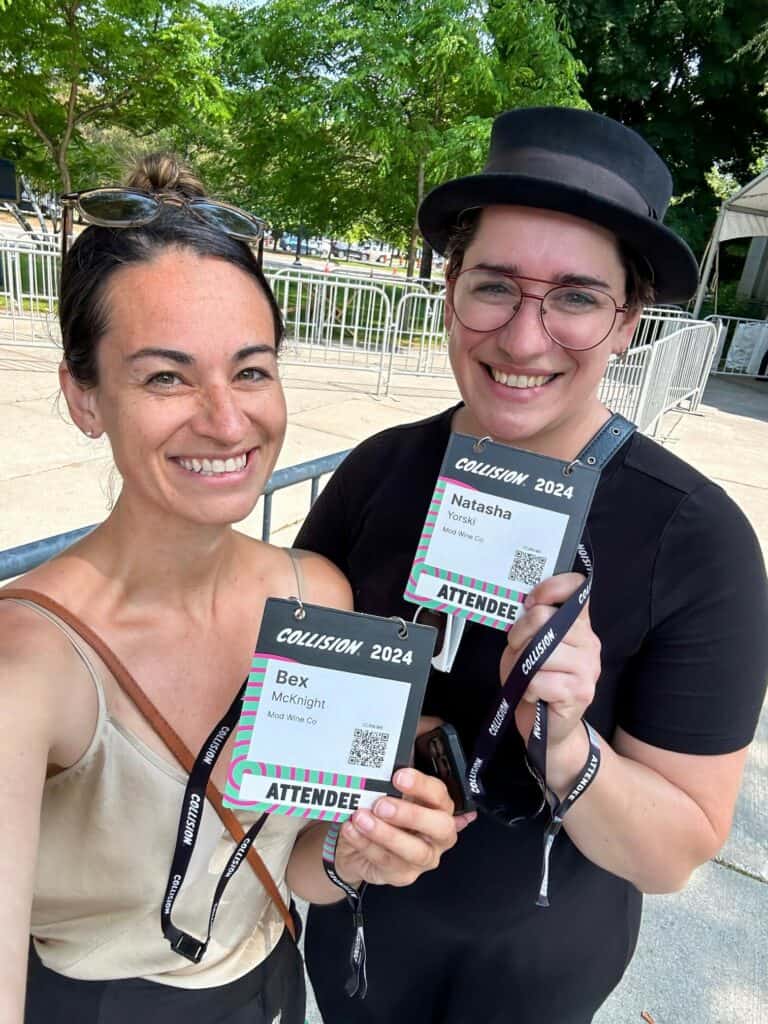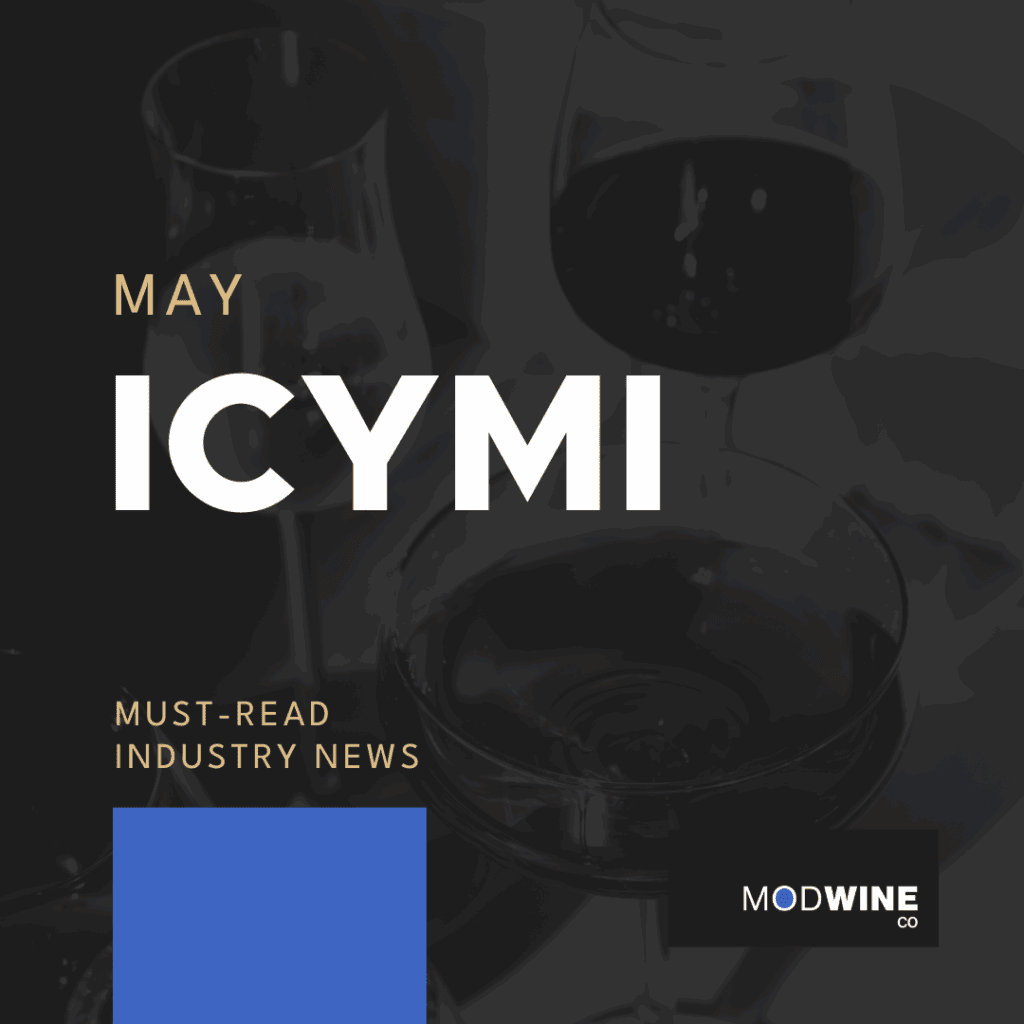Six months after wrapping up our second year at Collision—a dynamic 4-day marketing and tech conference that combines the energy of a summer festival with the insights of TED Talks—Bex and I are reflecting on its impact. With over 25 talks under our belts, we’ve had time to digest and refine the top 10 takeaways that remain highly relevant for the food & beverage sector and local wineries. These insights are more crucial than ever as brands strive to stay ahead in today’s fast-evolving market.
1. The Magic of Strategic Storytelling
Storytelling isn’t just for books and movies—it’s a game-changer in marketing. When you weave creative and strategic stories, you turn your brand from one of many products on the shelf into an unforgettable experience.
Did you know that storytelling is 22 times more memorable than those old static campaigns? Equally 64% of consumers cite shared values as the primary reason they have a relationship with a brand, emphasizing the need for brands to communicate their story and values effectively.
Your stories should aim to entertain, educate, and inspire. Every brand has its main character, so it’s crucial to plan where each story fits in your customer journey.
For wineries and food and beverage businesses, this means not just telling people about your products, but sharing your story, values, and the unique qualities that set you apart. This way, your brand becomes not just memorable, but also deeply relatable.
6 Month Update: 2024 has given us a multitude of incredibly interesting and noteworthy brand stories that have resonated with audiences around the world. Successful brand stories prioritize authenticity, emotional connection, and creative storytelling. Brands like Sweegen and Once Upon a Farm use authenticity and real customer stories to build trust, while Ben and Jerry’s and Speciation Cellars focus on transparency and cultural relevance. These examples showcase how brands effectively connect with audiences by staying true to their values.
2. Adapting to a Cookie-Less Future
The game of attracting customers is changing fast. With third-party cookies (bits of data from other websites that get saved on your computer when you visit a site which help advertisers track what you do online and show you ads based on your browsing habits) set to disappear by 2025, the cost of bringing in new customers has skyrocketed by 20-50% across various industries.
This shift means we need to focus more on keeping the customers we already have. While considering offering upsells, add-ons, unique experiences, and subscriptions, it is ultimately about building a strong community.
By using data and digital tools, you can better understand your audience and tailor your approach. Try targeted social media campaigns, email marketing, and collaborating with local influencers to connect with people who genuinely care about what you offer.
6 Month Update: On July 22, 2024 Google announced changes to its new Privacy Sandbox project and decided NOT to phase out third-party cookies. Instead the platform will offer “opt in/opt out” options to Google Chrome users so they’re able to make choices and adjustments to their web browsing tracking preferences going forward. HOWEVER, given how quickly this decision could be reversed in the future, we strongly recommend developing a strategy to gather and protect zero and first-party data—things like referral programs and organically growing your audience on platforms that align with your brand.
3. Zero Clicks, Maximum Impact
In an age where consumers want instant answers, your website needs to provide information quickly and efficiently.
Google’s new Search Generative Experience (SGE) will significantly change how search results are displayed, favoring generative AI summaries over promoting actual websites.
With 8.5 billion searches a day and 94% of pages getting no organic search traffic, diversifying your content strategy to include revenue-driven content is more crucial than ever. Addressing the “zero click” problem means optimizing your site so users find what they need without having to dig.
For wineries, this could mean having clear, accessible details about wine varieties, tasting notes, and purchasing options right on your homepage.
6 Month Update: 84% of search queries on Google are now influenced by the Search Generative Experience. The quality and relevancy of the generated results are still inconsistent across industries, but are set to improve as the tool develops.
4. Building and Engaging Communities
Creating a community around your brand can drive loyalty and repeat business. This involves more than just social media presence; it’s about creating a sense of belonging. According to recent data, 89% of consumers trust the opinions of people they know more than advertisements, highlighting the importance of fostering genuine connections.
6 Month Update: Customer loyalty has remained a critical focus for the wine and restaurant industries, with 71% of consumers having switched brands at least once in the past year. However, 96% say excellent customer service builds trust, and 82% recommend companies based on this experience. Creating a sense of community around a brand has become more vital, especially with 61% of consumers expecting to shop more via social media in the next three years.
5. AI and the Future of Retail
Artificial Intelligence (AI) is transforming the retail landscape. AI tools can improve efficiency and enhance customer experiences, from personalized recommendations to inventory management.
The global AI in the retail market is projected to grow from $9.85 billion in 2024 to $40.49 billion by 2029, at a compound annual growth rate (CAGR) of 32.68%. It shouldn’t be ignored.
Industries across the board will see changes through AI-driven platforms that offer predictive analytics, automated customer service, and personalized marketing strategies.
By paying attention, brands and restaurants can use these tools to stay ahead in the competitive food and beverage market.
6 Month Update: AI has revolutionized the wine and restaurant industries. Apps like Vivino, with 45 million users, provide personalized recommendations, addressing the 93% of wine buyers who feel overwhelmed by choices. AI tools such as DRINKS have boosted conversions by 175% and revenue per session by 78% for major retailers. Beyond recommendations, AI is optimizing inventory management, predicting demand, and preventing overstock. Virtual wine tastings powered by AI are also gaining traction, offering tailored experiences that drive engagement and sales.
6. Creating a Content Strategy in the Age of The Creator Economy
The Creator Economy is booming, and content is king. Anyone, with just a phone, can establish a presence in the digital sphere. There are over 200 million content creators worldwide who generate and share content with the intent to monetize it. The global creator economy is estimated to be worth $104.2 billion and is projected to reach $480 billion by 2027, showcasing its rapid growth and potential.
While it doesn’t require a significant investment of time and money, having a robust content strategy is crucial. Your strategy could include:
- Leverage user-generated content to diversify content
- Build influencer partnerships to reach new audiences
- Utilize authentic and impactful storytelling, such as showcasing behind-the-scenes glimpses of your operations to give your audience a peek into your brand’s personality.
- Highlight user testimonials to add a layer of trust and authenticity
These elements will keep your audience engaged and invested in your brand, helping you build a loyal community and stay ahead in the competitive market.
6 Month Update: The Creator Economy has continued its rapid expansion, and Influencer marketing on the rise, expected to grow to $24 billion by the end of 2024. For the wine and restaurant industries, building authentic connections with audiences through long-term influencer partnerships and user-generated content has become key to staying competitive. Over 60% of brands plan to integrate AI into influencer campaigns, further highlighting the need for a robust, personalized content strategy that emphasizes transparency and trust.
7. Brand Awareness vs. Brand Understanding
While brand awareness is crucial, brand understanding takes it a step further. Awareness gets your name out there, but understanding fosters a deeper connection. It’s the difference between someone just seeing your logo and someone feeling connected to your mission and values.
81% of consumers need to trust a brand to consider buying from them, highlighting the importance of building deeper connections beyond mere awareness.
Engage your audience with your journey, by sharing more personal elements, you create an emotional connection with your audience, turning customers into loyal advocates who truly understand and appreciate what makes your brand special.
6 Month Update: The importance of building deeper brand connections in the wine and restaurant industries has only grown. Consumers now demand more than just brand understanding—86% of them prioritize authenticity when deciding which brands to support. This shift highlights how vital it is for brands to foster true understanding and emotional connections. Emotionally connected customers are more than twice as valuable as satisfied ones, and 71% of those who feel this bond will recommend the brand to others. Purpose-driven brands, in particular, are thriving, as 65% of consumers prefer buying from brands they connect with on a personal level.
8. The Importance of a Good Brand Name
Brand naming is a critical aspect of branding that often gets overlooked. It’s essential because a good brand name can stand out in a crowded market, evoke emotions, and build lasting connections with consumers.
It takes people an average of 7 seconds to form an impression of your brand and 60% of consumers avoid companies with logos that have weird or unappealing designs, even if they have good reviews.
Effective brand naming requires a strategic approach, considering emotional impact, multilingual implications, and potential challenges like uniqueness and ease of pronunciation. The process typically involves creating a naming brief, brainstorming, shortlisting, screening, presenting, legal searching, and selecting the final name.
By investing time and resources into this process and consulting with experts, businesses can create a memorable and impactful brand name that aligns with their overall strategy and goals, ensuring long-term success.
6 Month Update: First impressions remain vital, with over 55% of consumers forming their opinions visually, highlighting the importance of both the brand name and logo in creating an immediate connection. Additionally, the brand naming process has become more structured and data-driven, with modern tools such as AI being used for real-time feedback on potential names. Securing digital presence and domain names is also essential, reinforcing the need for a name that works across all platforms.
9. The Role of Innovation in Sustainability
Sustainability is not just a trend; it’s a necessity in today’s market. Adopting innovative practices in packaging, sourcing, and production can differentiate your brand and appeal to a growing segment of eco-conscious consumers.
Equally, highlighting your sustainable practices and initiatives is crucial. For instance, using eco-friendly packaging made from recycled or biodegradable materials is important to 67% of consumers who prefer their purchases to be in recyclable packaging.
The statistics show that sustainability directly impacts purchasing decisions: 71% of consumers in 2023 have chosen a product in the last six months based on its sustainability credentials, and 90% of Gen-Z consumers are willing to pay more for sustainable packaging.
Furthermore, companies with high ratings for Environmental, Social, and Governance (ESG) performance enjoy average operating margins that are 3.7 times higher than those of lower ESG performers.
By showcasing these efforts, you demonstrate your dedication to environmental responsibility, which can attract and retain customers who value sustainability.
6 Month Update: Sustainability continues to be a key factor in purchasing decisions. 82% of consumers are willing to pay more for sustainable packaging, and 71% choose products based on eco-friendly credentials. Brands that clearly communicate their sustainability efforts can attract and retain environmentally conscious customers.
10. Navigating the Digital-Physical Hybrid Experience
The line between digital and physical experiences is blurring. Nearly 90% of consumers say that the experience a company delivers matters as much as products or services. This means that a seamless
hybrid experience for your customers by integrating online and offline touchpoints is critical.
This can be as simple as recognizing that certain customers will start their journey online, perhaps researching products on your website or social media, and then continue in-store with a smooth transition.
Features like online ordering with in-store pickup, personalized digital content, and interactive in-store technology can enhance this experience.
By ensuring that your digital and physical channels are interconnected and provide a consistent, engaging experience, you can meet and exceed customer expectations, fostering loyalty and satisfaction.
6 Month Update: The integration of digital and physical experiences has continued to grow in importance for the wine and restaurant industries. Nearly 1 in 3 shoppers now blend online and in-store experiences, with over 50% starting their journey online before visiting a physical location. Retailers offering services like buy-online-pick-up-in-store (BOPIS) and personalized digital experiences are successfully meeting customer expectations, emphasizing the need for seamless transitions between digital and physical touchpoints to foster loyalty and satisfaction.
Wondering how to take advantage of these marketing trends in your own business, but not sure where to start? Give us a shout!



